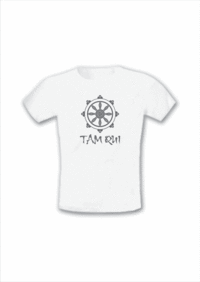Milarepa
From Buddha World
Jetsun Milarepa (c. 1052-c. 1135 CE) is generally considered one of Tibet's most famous yogis and poets, a student of Marpa Lotsawa, and a major figure in the history of the Kagyu (Bka'-brgyud) school of Tibetan Buddhism. The essence of Milarepa lies in his writings rather than the legends that have grown up around him. The writings, often referred to as the Songs of Milarepa, are canonical Mahayana Buddhist texts and in particular emphasize the temporary nature of the physical body and the need for non-attachment. In contrast, the legends of Milarepa's life are full of references to magic and lack the same sense of devout non-attachment. They are popularly known from the romanticized biography Mi-la-rnam-thar by Gtsang-smyon he-ru-ka rus-pa'i-rgyan-can (1452-1507); although they may be of questionable historic validity, the biographical details given in this article are based upon this account or its derivatives.
Early life and revenge
Born in the village of Kya Ngatsa - also known as Tsa - in Gungthang province of western Tibet to a prosperous family he was named Mila Thöpaga (Thos-pa-dga'), which means "A joy to hear." When his father died, Milarepa's uncle and aunt took all of the family's wealth. At his mother's request, Milarepa left home and studied sorcery. While his aunt and uncle were having a party to celebrate the impending marriage of their son, he took his revenge by summoning a giant scorpion to demolish their house, killing 35 people, although the uncle and aunt are supposed to have survived. The villagers were angry and set off to look for Milarepa, but his mother got word to him and he sent a hailstorm to destroy their crops.
Tutelage under Marpa
Knowing that his revenge was wrong, Milarepa set out to find a lama and was led to Marpa the translator. Marpa proved a hard task master. Before Marpa would teach Milarepa he had him build and then demolish three towers in turn. When Marpa still refused to teach Milarepa he went to Marpa's wife, who took pity on him. She forged a letter of introduction to another teacher, Lama Ngogdun Chudor, under whose tutelage he began to practice meditation. However when he was making no progress, he confessed the forgery and Ngogdun Chudor said that it was vain to hope for spiritual growth without the guru Marpa's approval. Milarepa returned to Marpa, and after practicing very diligently for twelve years Milarepa attained the state of Vajradhara (complete enlightenment). He is said to be the first to achieve this state within one lifetime. He then became known as Milarepa, which means the "Mila, the cotton clad one" (the suffix "repa" is given to many tantric yogis since they wear white robes) At the age of forty-five, he started to practice at Drakar Taso (White Rock Horse Tooth) cave - 'Milarepa's Cave', as well as becoming a wandering teacher. Here, he subsisted on nettle tea, leading his skin to turn green, hence the greenish color he is often depicted as having in paintings and sculpture. Pyenzhangling Monastery, also known as Pelgye Ling Gompa, is a small Tibetan Buddhist monastery in a tiny village called Zhonggang, Tibet that is consecrated to Milarepa. It is built around the cave where he once lived. "It was destroyed but has now been rebuilt and decorated by Nepali artisans. This is one of many caves associated with Milarepa between Langtang and Jomolungma."
Lineage
Milarepa is famous for many of his songs and poems, in which he expresses the profundity of his realization of the dharma with extraordinary clarity and beauty. He also had many disciples, male and female, which include Rechung Dorje Drakpa (Ras-chung Rdo-rje Grags-pa), Gampopa (Sgam-po-pa) or Dhakpo Lhaje. It was Gampopa who became his spiritual successor who continued his lineage and became one of the main lineage masters in Milarepa's tradition.
Supernatural running
According to the book Magic and Mystery in Tibet by French explorer Alexandra David-Néel, Milarepa boasted of having “crossed in a few days, a distance which, before his training in black magic, had taken him more than a month. He ascribes his gift to the clever control of ‘internal air’.” David-Néel comments “that at the house of the lama who taught him black magic there lived a trapa [monk] who was fleeter than a horse” using the same skill. This esoteric skill, which is known as Lung-gom-pa ("Wind Meditation", lung = “wind, gom-pa = “meditation”) in Tibet, allows a practitioner to run at an extraordinary speed for days without stopping. This technique could be compared to that practiced by the Kaihigyo Monks of Mt. Hiei in Kyoto, Japan. It is also described in some accounts that Milarepa's supernatural speed of travel was due to the fact that he had the ability to fly.


 По-Русски
По-Русски
